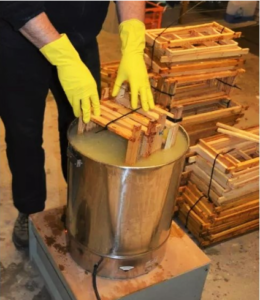Maintaining a beehive: The Do’s and Don’ts

Maintaining a beehive can be an intimidating prospect for a beginner beekeeper. With so much to learn, it’s no wonder that many find themselves unsure of where to start. Before buying one, make sure to research different beehive prices and their advantages to know which one you can manage best. With the right knowledge and proper practices, keeping a beehive can be a rewarding and educational experience. Let’s explore the dos and don’ts of maintaining a beehive. Read on to learn more about how to keep your beehive in perfect condition.
Inspect your hive regularly
To keep your beehive healthy and productive, you must inspect your hive regularly – at least every two weeks. When inspecting the hive, check for signs of disease, pest infestations, and any other abnormalities.
You should pay particular attention to the condition of the frames and combs, looking for cracks and other damage that could harm the bees. Also, check for any larvae or dead bees on the frames and remove them if necessary. You should also inspect the honeycomb to make sure that there is a good amount of nectar and pollen being stored by the bees.
It is also important to monitor the population of the hive. Make sure that there are plenty of worker bees and a healthy queen bee. The presence of queen cells indicates that there may be swarming behavior soon, so take preventative measures if necessary.
Keep an eye out for pests
Pests are a common problem when it comes to beekeeping. It is important to regularly inspect your hives for any signs of pests, as well as for any other signs of distress. Some common pests include varroa mites, small hive beetles, wax moths, and ants.
Varroa mites feed on the blood of bees and can weaken the entire hive if left unchecked. Look for signs such as reduced brood production, discolored or weakened honeycomb, and unusually high levels of dead bees around the hive entrance. If you see any of these signs, you should treat your hive with an appropriate varroa mite treatment.
Small hive beetles can be found in your hive’s comb and can cause destruction by tunneling through the comb and eating stored pollen and honey. To help prevent small hive beetle infestation, make sure to regularly inspect your frames for any signs of their presence and quickly remove them from the hive.
Wax moths can damage the comb in a similar way to small hive beetles, but they also lay their eggs in the comb, which can cause further destruction when the larvae hatch. Inspect your frames for signs of a wax moth infestation and quickly remove any that you find.
Finally, ants can also be a problem for beekeepers. They are attracted to the sweet smells of honey and nectar and will often try to get inside the hive in search of food. You can prevent ants from getting into the hive by making sure there are no openings or cracks in your hive, as well as by placing ant traps near the entrance.
Make sure your hive has enough ventilation
Proper ventilation is essential for a healthy beehive. Without proper airflow, the hive can quickly become overcrowded and the bees may become stressed.
To ensure that your hive has sufficient ventilation, you should create openings in the hive walls to allow for air to flow through. If you’re using a Langstroth-style hive, there are special ventilation slots located on either side of the frames. For other types of hives, it is generally recommended that you place an opening in the bottom and top of the hive. Make sure these openings are the same size as your bee entrances, so the bees can easily move air through their nest.
You should also check regularly to make sure that the bees haven’t blocked off the ventilation openings with propolis or wax. If they have, simply scrape away any buildup. It’s also important to make sure that your hive is not in direct sunlight and is not positioned in a drafty area.
Finally, you should never block up the entrance or ventilation openings during winter months when the colony is inactive. Doing so could prevent necessary air circulation and can lead to serious issues with the health of your colony
Keep your hive clean
A clean hive is essential for a healthy colony of bees. It’s important to regularly inspect and maintain your hive to make sure it’s clean and free from pests or disease. Here are some tips on how to keep your hive clean:
- Remove any old or moldy honeycomb from the hive, as this can attract pests or diseases.
- Check for debris and dirt inside the hive and remove any that you find.
- Regularly check the area around the entrance to the hive for signs of dirt, debris, or pests.
- If you notice signs of pests, take immediate action to remove them.
- Clean out the bottom board regularly to make sure it isn’t blocked or clogged up.
- Make sure there are no dead bees in the hive, as this can attract other pests or spread diseases
- Look out for accumulated propolis on the frames or outer surface of the hive. Propolis can interfere with the ventilation of the hive and can cause the temperatures to fluctuate.
By following these steps, you can help ensure that your bees stay healthy and productive.
Don’t disturb the bees too much
One of the most important rules to remember when maintaining a beehive is to not disturb the bees too much. Bees are very sensitive creatures, and too much disruption can cause them great stress. You should check on your hive regularly to ensure its health and safety, but you should also avoid any unnecessary disturbance.
If you need to open the hive for any reason, it is best to do so in the morning or evening when the activity within the hive is minimal. When opening the hive, make sure to move slowly and calmly, and avoid making loud noises or excessive movements. As much as possible, avoid taking out any frames or combs and only touch what is necessary.
When you’re done inspecting the hive, be sure to close it as quickly as possible. Doing so will help to keep the temperature inside the hive stable and protect the bees from predators and parasites.
If your hive has been left untouched for a while, it may be home to a swarm. Swarms are clusters of bees that leave their old hive in search of a new home. If this is the case, it is important to act with caution. Make sure to contact an experienced beekeeper who can help you safely remove the swarm without causing them too much stress or harm.
Caring for bees is a long-term commitment and regular inspections are essential for keeping them thriving.


